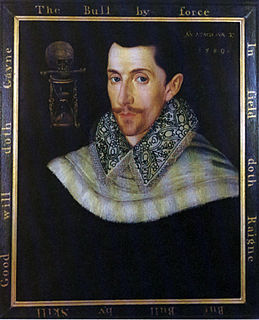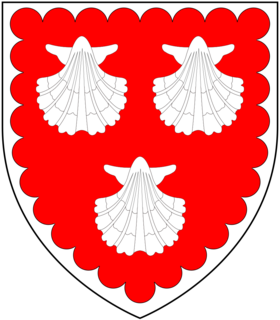Related Research Articles

John Dowland was an English Renaissance composer, lutenist, and singer. He is best known today for his melancholy songs such as "Come, heavy sleep", "Come again", "Flow my tears", "I saw my Lady weepe" and "In darkness let me dwell", but his instrumental music has undergone a major revival, and with the 20th century's early music revival, has been a continuing source of repertoire for lutenists and classical guitarists.
Thomas Robinson was an English Renaissance composer and music teacher, who flourished around 1600. He taught and wrote music for lute, cittern, orpharion, bandora, viol, and voice.

The virginals is a keyboard instrument of the harpsichord family. It was popular in Europe during the late Renaissance and early baroque periods.

The Fitzwilliam Virginal Book is a primary source of keyboard music from the late Elizabethan and early Jacobean periods in England, i.e., the late Renaissance and very early Baroque. It takes its name from Viscount Fitzwilliam who bequeathed this manuscript collection to Cambridge University in 1816. It is now deposited in the Fitzwilliam Museum at Cambridge. Although the word virginals or virginal is used today to refer to a specific instrument similar to a small, portable harpsichord, at the time of the book the word was used to denote virtually any keyboard instrument including the organ.

John Bull was an English composer, musician and organ builder. He was a renowned keyboard performer of the virginalist school and most of his compositions were written for this medium.

In English early Baroque music, a broken consort is an ensemble featuring instruments from more than one family, for example a group featuring both string and wind instruments. A consort consisting entirely of instruments of the same family, on the other hand, was referred to as a "whole consort", though this expression is not found until well into the seventeenth century. The word "consort", used in this way, is an earlier form of "concert", according to one opinion, while other sources hold the reverse: that it comes from the French term concert or its Italian parent term concerto, in its sixteenth-century sense. Matthew Locke published pieces for whole and broken consorts of two to six parts as late as 1672.

Parthenia or the Maydenhead of the first musicke that ever was printed for the Virginalls was, as the title states, the first printed collection of music for keyboard in England. 'Virginals' was a generic word at the time that covered all plucked keyboard instruments – the harpsichord, muselaar and virginals, but most of the pieces are also suited for the clavichord and chamber organ. Though the date is uncertain, it was probably published around 1612. The 21 pieces included are ascribed to William Byrd, John Bull, and Orlando Gibbons, in three sections.
My Ladye Nevells Booke is a music manuscript containing keyboard pieces by the English composer William Byrd, and, together with the Fitzwilliam Virginal Book, one of the most important collections of Renaissance keyboard music.
Martin Peerson was an English composer, organist and virginalist. Despite Roman Catholic leanings at a time when it was illegal not to subscribe to Church of England beliefs and practices, he was highly esteemed for his musical abilities and held posts at St Paul's Cathedral and, it is believed, Westminster Abbey. His output included both sacred and secular music in forms such as consort music, keyboard pieces, madrigals and motets.
The Mulliner Book is a historically important musical commonplace book compiled, probably between about 1545 and 1570, by Thomas Mulliner, about whom practically nothing is known, except that he figures in 1563 as modulator organorum (organist) of Corpus Christi College, Oxford. He is believed to have previously resided in London, where John Heywood inscribed the title page of the manuscript Sum liber thomas mullineri / iohanne heywoode teste. A later annotation on the same page states that: T. Mulliner was Master of St Pauls school, but this has so far proved unsupportable. The provenance of the MS is unknown before it appears in the library of John Stafford Smith in 1776. After passing through the hands of Edward Francis Rimbault the MS was given to the British Museum in 1877 by William Hayman Cummings.
Priscilla Bunbury's Virginal Book is a musical commonplace book compiled in the late 1630s by two young women from an affluent Cheshire family. It is important more for its fingering indications than for the quality of the music it contains.
Virginalist denotes a composer of the so-called virginalist school, and usually refers to the English keyboard composers of the late Tudor and early Jacobean periods. The term does not appear to have been applied earlier than the 19th century. Although the virginals was among the most popular keyboard instruments of this period, there is no evidence that the composers wrote exclusively for this instrument, and their music is equally suited to the harpsichord, the clavichord or the chamber organ.
The Dublin Virginal Manuscript is an important anthology of keyboard music kept in the library of Trinity College, Dublin, where it has been since the 17th century under the present shelf-list TCD Ms D.3.29.
Anne Cromwell's Virginal Book is a manuscript keyboard compilation dated 1638. Whilst the importance of the music it contains is not high, it reveals the sort of keyboard music that was being played in the home at this time.
Clement Matchett's Virginal Book is a musical manuscript from the late renaissance compiled by a young Norfolk man in 1612. Although a small anthology, it is notable not only for the quality of its music but also for the precise fingering indications that reveal the contemporary treatment of phrasing and articulation. Moreover, the manuscript is unusual in that each piece bears the exact date of its copying.
The Susanne van Soldt Manuscript is a keyboard anthology dated 1599 consisting of 33 pieces copied by or for a young Flemish or Dutch girl living in London. Its importance lies mostly in the fact that it is the only known source of early Dutch keyboard music prior to Sweelinck.

Drexel 4257, also known by an inscription on its first page, "John Gamble, his booke, amen 1659" is a music manuscript commonplace book. It is the largest collection of English songs from the first half to the middle of the 17th century, and is an important source for studying vocal music in its transition from Renaissance music to Baroque music in England. Many songs also provide commentary on contemporary political events leading up to the Restoration.

Drexel 4302, also known as the Sambrook Book based on an inscription from a former owner, Francis Sambrook, is a music manuscript containing vocal and keyboard music from Italian and British composers, documenting the transition from Renaissance to Baroque music. Though literature on the manuscript has assumed the copyist was Francis Tregian the Younger, recent analysis has demolished that hypothesis.
Parthenia Inviolata, or Mayden-Musicke for the Virginalls and Bass-Viol is the second book of keyboard music printed in England, containing twenty pieces scored for virginal and bass viol.

Walter Erle (c.1515/20-1581) of Colcombe in the parish of Colyton, of Bindon in the parish of Axmouth, both in Devon, and of Charborough in Dorset, England, was a courtier and servant of the Royal Household to two of the wives of King Henry VIII, namely Catherine Howard and Catherine Parr, and successively to his son King Edward VI (1547-1553) and two daughters, Queen Mary I (1553-1558) and Queen Elizabeth I (1558-1603) during their successive reigns. According to Sandon (1983) his popularity as a royal courtier was in part due to his ability as a musician, particularly as a player of the virginal. He is known to have composed at least one work of church music, namely Ave Vulnus Lateris, a short votive antiphon in honour of one of the Five Holy Wounds of Jesus, his authorship of which is recorded in Peterhouse College manuscripts 471–474, held in the Cambridge University Library, comprising four partbooks from a set of five copied late in the reign of King Henry VIII, which contain seventy-two pieces of Latin church music. As a courtier-musician he well represents the ideal royal courtier described in The Courtier by Baldassare Castiglione (d.1529) and also in The Boke Named The Governour by Sir Thomas Elyot (d.1546). Although he was born into a minor gentry family of Devonshire, he founded a dynasty of substantial landed gentry that survives to the present day, his heir being the Conservative Member of Parliament Richard Grosvenor Plunkett-Ernle-Erle-Drax, of Charborough House.
References
- ↑ Sargent, George (1971). Elizabeth Rogers' Virginal Book 1656 (PDF). American Institute of Musicology. Retrieved 23 January 2015.
- ↑ Sargent, George (1971). Elizabeth Rogers' Virginal Book 1656 (PDF). American Institute of Musicology. Retrieved 23 January 2015.